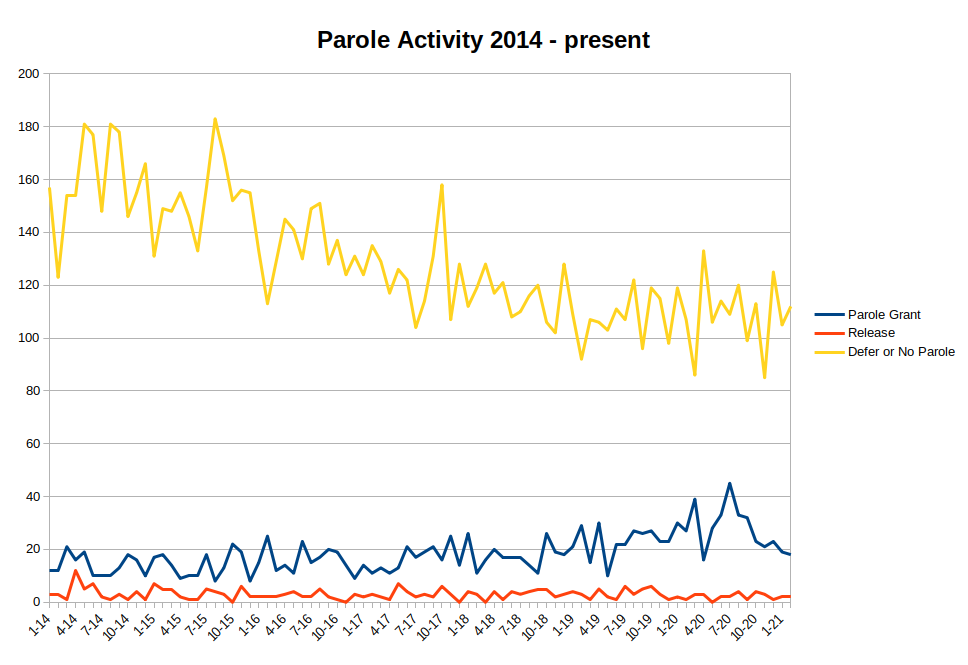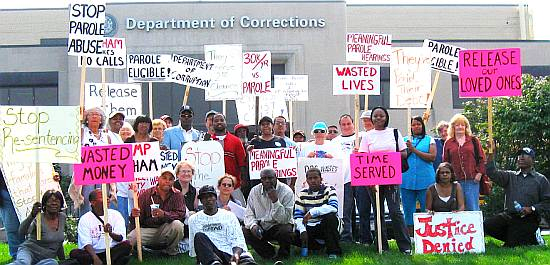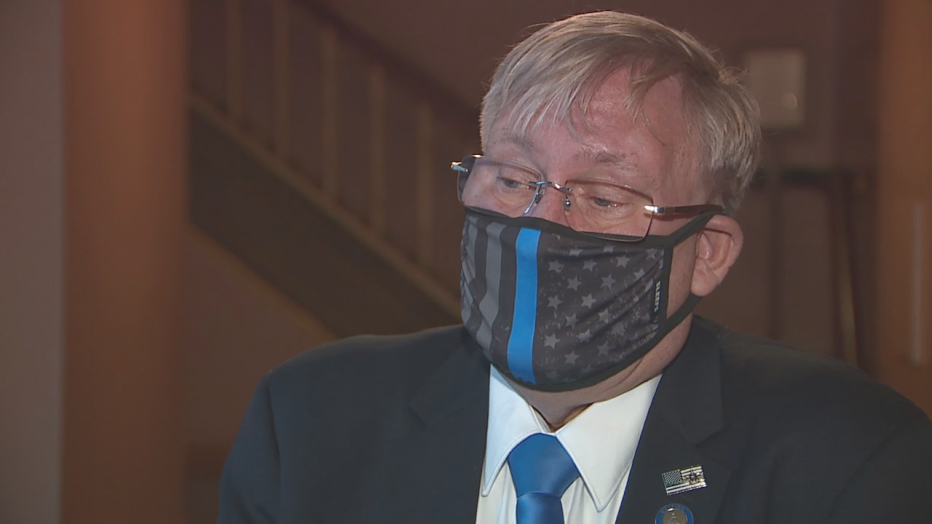
At last month’s Parole Commission staff meeting, the Chair, John Tate II made an interesting statement about the number of people the commission had granted releases to in the last year. Last Saturday, April 3, was the National Freedom Movement’s ParoleWatch2021 event, and the commission’s next monthly meeting is Wednesday morning (you can attend at 10 am via zoom here). so this seems like a good time to go in-depth about Tate’s work on the commission.
John Tate II came into his role as a reformer. He is a very diplomatic man and he’s in a delicate situation. Some who know and trust him believe he is doing the best he can in that situation, but anyone who is suffering, or knows and loves someone suffering in prison under the old law, knows that John Tate’s best has not been good enough.
If justice, fairness, reason, or any higher minded values held sway in Wisconsin, everyone serving under the old law, all 2800 of them, would be released by now. Organizers with FFUP, WISDOM, and the ACLU have been fighting to release people sentenced under the old law for years. The 53206 documentary featured the intransigent corruption of the parole commission in regards to one family: Baron and Beverly Walker. The commission and two-faced Milwaukee DA John Chisolm caved to pressure in Baron’s case, but they were very careful to ensure that his release would not create a precedent for the thousands of others in his same circumstances.
John Tate II holds the keys to these people’s cages, and he overwhelmingly refuses them freedom.
We hope that by breaking down his statements from the last meeting and looking at some data we can shed some light onto what’s preventing him from doing what’s right, and empower more people to join us in demanding change. We’ll go into what Tate said in detail, explain jargon, give background, and respond critically.

Tate’s words are in quotes and italics.
“I do want to share some quick updates, just as far as data, because we are still progressing through the litigation with the ACLU as it relates to juvenile lifers.”
He’s referring to a lawsuit filed by the ACLU in April 2019, which is part of a national campaign of similar lawsuits following a 2012 US Supreme Court decision against mandatory life without parole for juveniles. Last we heard, the Wisconsin suit is on hold awaiting precedent from one of the similar cases in another state.
Back to Tate:
“I’ve gotten a little bit of… well just some natural follow up with progress since we’ve been here. I… yeah, I’ll say it… in the last year, in 2020… y’know, it’s been very different from previous years…”
We want to draw attention to Tate’s hesitation here. The work of the parole commission is a matter of public record. We requested those records going back to 2014, and we’ll get into them later, but first, why is he so uncertain about sharing this publicly available information? He also alluded to coronavirus when he said “2020… it’s been very different” which suggests that the pandemic, a temporary situation, is the reason for increased parole grants. Is he signaling that 2021 will see fewer releases?
Dramatically Different than Previous Years
Tate continued: “last year we authorized… between yourselves and myself–grant recommendations as well as interventions on my part–over 200 parole grants. Which is dramatically different from previous years and probably the highest in a really long time. That doesn’t mean that every grant that was issued resulted in a release… some were paroled to TIS, some to detainers, but many paroled back to the community.”
There’s some jargon to explain here. All the decisions of the parole commission are made by the chair. The other commissioners make recommendations, generally to either “grant” someone parole, or to “defer” them. Tate has the option to “intervene” and issue a grant or deferral even if the commissioner recommended the opposite.
TIS stands for Truth In Sentencing, which is the law that eliminated parole in Wisconsin in 2000. So, someone “paroled to TIS” must have been sentenced for multiple crimes, some before and some after 2000. They’ve been paroled from the pre-2000 sentence, only to serve the post-2000 sentence. Someone paroled “to detainer” must have been sentenced both in Wisconsin and in another state, or under federal law. The parole grant releases them from Wisconsin, to serve their sentence in the other jurisdiction.
Paroled “back to the community” means released from prison, but still monitored by the prison system’s “community supervision” division (DCC). People on supervision can be reincarcerated by DCC agents for a variety of petty rule violations. More on that later.
“I just wanted to note that your efforts to really evaluate individuals where they are, giving that real chance… as well as individuals own progress, resulted in a great deal of people being able to return to the community… So, i just wanted to give you kudos, and give you all an update in terms of what sort of activity has occurred in the past year, and what that means for 200 plus families who are receiving back, well… not 200 per say, but a lot of families are getting back loved ones who they haven’t seen for a long time, and what that means for them.”
Tate holds up these 200 grants as a reformist achievement, but it is only an achievement when compared with his immediate predecessors, who set a very low expectation. Tate’s 200 release grants in a year is small compared to how parole worked before the institution of TIS on Dec 31, 2000. Considering that he’s only reviewing cases of people sentenced before that date, people decades away from their misdeeds, it is an absurdly meager accomplishment.
Here’s the data the parole commission released in response to our record request. It includes some confusing technical distinctions between types of decisions, and the numbers do not match Tate’s statement, or add up properly in general. According to the record, Tate granted 380 paroles in 2020, and there were more than 1500 grants since 2014. In 2014 there were only 3000 people held under the old law, and in 2019 there were still 2800, so something isn’t right with this data. The convoluted imprecision with which the prison system is allowed to operate will never cease to amaze us, but we made our best effort to break the data down into something legible. We are not statisticians, but there are not enough statisticians paying attention. Anyone who is able to better explain or bring clarity to this situation, please contact us at abolishmke@protonmail.com

The yellow line indicates all the people who the parole chair refused to release, and the blue line indicates the number of paroles granted. The orange line is people who the chair held back until their sentence maxed out entirely. Tate came into office in June of 2019, and we can see a clear, but inconstant increase in parole grants with his arrival.
For his first few months in office, Tate was beset with commissioners and staff quitting abruptly and actively sabotaging the work of the commission. He often gave people automatic two month defers because the commission was unable to hold actual hearings. We can see that he increased releases after fixing the staff problems. The Forum For Understanding Prisons (FFUP) also organized a rally and brought a large public turn out to the commission’s staff meeting in February 2020, which hopefully increased his confidence.
After a steep dip in both hearings and grants in April 2020, likely caused by adjusting to the pandemic, Tate’s release grants peaked, and have since steadily declined. Overall, Tate’s grant rate remains 5% higher than his predecessor’s average. In short, progress toward a functional parole system is being made. However, if we look at the old law parole situation from a criminological and historical perspective, that progress is far from impressive.
Revocation, Desistance, and Parole
After congratulating his staff for increased releases, Tate discussed re-incarceration.
“To date, I only know of one person who has been released during my tenure who has returned back to incarceration. It was for an offence unrelated to the reason why they were paroled. So percentage-wise, I think that’s a very good thing, and to be expected because a lot of these folks spent a lot of time in prison and worked very hard to find themselves back in the community, and I believe very few… are interested or planning to or even going to consider engaging in behavior that will find themselves back here or back incarcerated.”
Only one in 200 being reincarcerated shows the absurdly high standard parole-eligible people have been held to. Parole is designed to transition people out of prison. It is not John Tate’s job to pursue a 100% success rate on releases. He is supposed to balance risk, weighing the chance that someone released will do significant harm to the community against the harm that holding them does to their family, their psyche, and to taxpayers. If 99.5% of people he released evade reincarceration, that doesn’t indicate success or a “very good thing… percentage-wise” it indicates a very poor balance of risk.
Everyone granted parole still completes the rest of their sentence under community supervision. That means they could get reincarcerated not only for breaking laws, but for breaking an array of petty rules, as enforced by DCC agents. We can compare Tate’s parole releases to people sentenced under TIS, after parole was eliminated. The DCC reincarcerates people sentenced under TIS incredibly frequently.
A 2019 report from the Columbia Justice Lab shows that Wisconsin’s supervision system is a racist gauntlet that is extraordinarily difficult to escape. Aggressive DCC agents reincarcerate people for rules-only or crimeless violations more often than courts sentence people to prison for committing crimes. If only one of Tate’s 200 releases failed this gauntlet, while DCC sends roughly 7,500 people back over three years’ time, that confirms what we’ve all known for many years: the parole commission is holding the people they review to excessively strict standards.
Statistically, the people Tate is reviewing have lower release risks, but he puts them through the most scrutiny and releases them with great hesitation. Everyone the parole commission evaluates was sentenced before December 31, 1999. Even someone aged 16 in 1999 and sentenced as an adult would be 36 now. One of the few widely accepted criminological facts that even prisonphiles like the amerikan office of justice programs agrees on is the age-crime curve. It has been observed that people “age-out” of criminal behavior in their late 20s.
We hesitate to rely on these studies, because the bulk of criminology, especially statistical criminology is based on problematic and foolish assumptions about the effectiveness and purpose of police and prison. For example, these studies rely on arrest data to demonstrate “desistance or persistence” in criminal behavior. In reality, arrest data primarily demonstrates the targeting choices of police departments, not the behavior of human beings. Nevertheless, these statistics form the “conventional wisdom” and twisted fantasy logic of the prison system.
Within that fantasy logic, it is widely accepted that people over the age of 36 are unlikely to commit more crimes, especially crimes that pose serious harm to others. Crime is most often a response to trauma, and younger people are far more likely to take impulsive risks when negotiating their traumas, especially the trauma of incarceration. People sentenced under TIS are naturally younger today than people sentenced to parole before 2000, so everyone Tate and his commissioners see tends to be lower risk than people sentenced under TIS.
Age isn’t the only factor reducing the risk of granting parole relative to TIS. People on TIS had their release date set by their sentencing judges. They get out because they’ve maxed out their sentences, not because they’ve stepped down to lower security levels, prepared for release, or demonstrated readiness in anyway, like parolees do. TIS captives are more likely to be going from maximum security, sometimes even years in solitary confinement, directly to the street. Re-entry is much more likely to go wrong when transitioning from a highly controlled, maximum security regime to the unstructured environment of a low-income community. Additionally, the kinds of convictions Tate’s people have served, those carrying 20+ year sentences, tend to result from very situational crimes, with low recidivism rates.
Parole-eligible prisoners are statistically likely to be among the least likely to harm anyone on release, but Tate holds them until he’s 99.5% sure they won’t violate petty rules of their DCC agents. Like so many aspects of the prison system, the patterns and practices are directly opposite what they would be if public safety was the primary concern.

What all this means, is that Tate is failing at his job. He is balancing risk poorly, being excessively cautious around the potential harm that a person released on parole may cause and excessively accepting of the harms caused to the people who remain captured, and to their families.
The Self-Serving Carceral Fantasy
Tate’s above comments about how people he’s released are not “planning to or even going to consider engaging in behavior that will find themselves back here or back incarcerated” belies a typical, but fundamentally naive understanding of how carcerality in amerika functions. Incarceration does not correlate with behavior or choices nearly as strongly as it correlates with race and class. Suburban, upper class white people engage in harmful and illegal behavior without consequence all the time. Meanwhile, poor and working class people, especially poor and working class people of color get incarcerated frequently for behavior that is not harmful to anyone. The people Tate is talking about–people on community supervision–can easily get reincarcerated for behavior that is not even illegal. A person cannot make plans to change their race, or simply reconsider their class position, but those are the real factors tending to get them incarcerated.
As a social worker and alderperson, Tate’s understanding of the prison system is hopefully not as naive as these comments make him sound. It could be that he’s again being diplomatic, performing along with the fantasy thinking of the childish prison officials, other commissioners, and prisonphile politicians his current post requires him to interact with.
All of those people engage in these myths about crime and behavior because they personally benefit from maintaining the illusion. Incarcerating people is what puts money in their pockets, and this is true of John Tate as well. The parole commission budget is $669,000 per year. This is for an office of 4 commissioners (including the chair), and 3 staff people. According to this job listing, starting salary for commissioners is “between $48,630 and $80,267 per year, plus excellent benefits.” Their overhead is low, because all they do is talk to prison captives and find excuses to keep them locked up. We’re guessing Tate makes $80-100,000 a year. His job is a vestigial remnant of a changed law. If he actually released all the low-risk captives, everyone who had exceeded the age-crime desistance curve, he would release everyone the commission sees, effectively closing it and putting himself and his staff out of a job.
Instead, Tate nibbles at the list and maintains fantasy rhetoric about keeping elderly people behind bars as though it has anything to do with public safety. Maybe he’s appeasing fantastical thinking of the right-wingers he has to work with, but that’s surely easier to do when it also means protecting an $80 grand per year paycheck.
The Human and Financial Costs of Hesitance
The next part of Tate’s statement takes this fantasy rhetoric to another level. He actually puts a positive spin on the deaths of elderly people his commission needlessly torments in prison:
“Also, I’ve been following up and getting information that some folks have passed since they were released, and it is that much more important to understand that- that any time folks might get outside prison, between their release and when their life may end is valuable to those who are close to them. That’s an important part of what we do, as much as we consider and accept and integrate into our decisions the impact on the community from the victim’s side it also impacts the community on the family side.”
The parole commission didn’t release enough information to let us determine how many people have died since release, or how long they held out before succumbing to diseases that were likely neglected for decades in the DOC’s captivity. We also don’t know how many parole-eligible people have died in prison after Tate refused to grant their release, but we know that Tate defers people far more often than he releases them.
According to the data from the records release, his grant rate has fluctuated between 11% and 29%. That means each month he chose to leave 71 to 89% of the people he could release trapped, separated from their families, left to potentially die in prison. John Tate would surely rather focus on the few months that the few people he released were able to spend with family, but we want to think about the countless months that hundreds or thousands of people have suffered in separation due to his stinginess.
Again, Tate has released more people than his immediate predecessors, but that doesn’t make him a hero. He is still working a job based on causing others great and prolonged suffering.
Tate’s job also wastes a lot of money. The Wisconsin prison system costs taxpayers $39,000 per captive, per year. When Tate denies someone release, he extends that cost. By his own estimate, he’s holding on to people who have a less than 1% chance of being reincarcerated. That’s not a less than 1% chance of committing a violent crime, it’s a less than 1% chance of breaking a supervision rule.
Again, the numbers are inconsistent, and we’d love to see a more precise accounting, but we’ll attempt an estimate. According to Tate, he issued 200 grants in 2020. Reporters said there were 2,800 people held under the old law when Tate started, so he’s left 2,600 people confined. If we go by the numbers from the record request, he’s issued 559 grants since taking the job, but denied 2,301. Many of his denials are elderly people, requiring more medical treatment and expense than the average DOC captive, so $39,000 each is a low-ball estimate. If we factor in the commission’s $669,000 budget which would disappear if they released people at the rate the system was designed for, this absurd exercise is likely costing taxpayers upwards of $100 million per year.
Political Delicacy
We’ve talked about Tate’s diplomacy and the fantasy rhetoric he uses to appease his facile right-wing collaborators. Immediately preceding his statement on the 200 parole grants, he gave us an explanation for why such diplomacy is required of a reformer in his position.
“Just a quick update from me, reappointment paperwork has been submitted to the senate and judiciary committee. I have officially been reappointed by the Governor for next term, to expire in 2023, so, hooray. I’m still not confirmed, so still got to go through that, but obviously the last year and a half I have not been confirmed. That hasn’t changed very much. Happy to continue to be here to continue to serve and work with the commission and working with you all as we perform our duty to the state.”
Tate is referring to the fact that he has been acting parole commission chair since June 2019, but he was never given a confirmation hearing by the Senate Judiciary and Public Safety Committee. That means if he pushes reform too far, the Republicans need only schedule a confirmation hearing to fire him. He is supposed to work for the Governor, but, by delaying his confirmation, the legislature is effectively holding power over him. Tate’s is not the only confirmation that Wisconsin’s illegitimate, racist legislature has withheld or delayed to prevent the Governor from acting in the will of the people who elected him. The people also would have elected a Democratic legislature alongside Governor Evers, if the Republicans hadn’t rigged the game against the people back in 2010.

Racist former cop Van Wanggaard, a Senator representing a gerrymandered district surrounding the city of Racine, is the chair of the committee that won’t confirm Tate. Organizers with FFUP met with Wanggaard in July 2019 during an action demanding the parole commission return to functional release criteria. Wanggaard told organizers “he supports [Tate’s] confirmation, that he knows John Tate… He expects the confirmations will go through in September.” Unsurprisingly, Wanggaard was lying. Instead, he has blocked Tate’s confirmation for going on two years now.
John Tate insists that not being confirmed hasn’t affected his work at all. If that’s true, then Tate’s natural inclinations as a reformer are very poor.
Tate’s Predecessors
Van Wanggaard and other racists in the senate are probably keeping John Tate on such a short leash because he’s Black. In 2003 Governor Jim Doyle appointed the first Black man to chair the parole commission, and it did not go well for the police.
Lenard “Lenny” Wells was appointed parole commission chair in 2003. He was confirmed without delay and openly embraced a functional parole commission that released people who met reasonable criteria. Though he was a former cop himself, he publicly recognized the harm and waste that comes with putting cops and prisons above social programs and education. Wells continued to work as an educator until he died of covid last year.
In 2006, two men who had served 30 years for killing a cop came up for parole. According to his recent obituary in the Journal Sentinel, “Wells said as a former officer, he did not want to see them released, but under the law, they were eligible and had completed other requirements for parole. He decided to free the men and faced intense criticism.” The intense criticism led to his resignation from the parole commission.
Governor Jim Doyle replaced Wells with Alfonso Graham, another Black man, who Doyle was confident “would not parole a cop killer”. Indeed, Graham started the tradition of paroling dramatically fewer people. Under Scott Walker, parole grants slowed to a crawl. The commission was releasing so few people that Walker shrunk it down and nearly abolished it to save money. He must have figured that Wisconsin doesn’t need more than one person to rubber stamp parole deferrals.
John Tate II is gradually, cautiously, rehabilitating the parole commission. He could go faster. He’s a social worker and reformer, but his average grant rate is not much higher than Lenny Wells, a former cop who was reviewing these same cases back in 2003, when the parolees were decades younger, presenting a much higher release risk.
At the same time, if John Tate emulates Lenny Wells too much, if he pushes too far, releases the wrong person, or drops the silly, coddling, and racially-coded language about middle aged and elderly people potentially “choosing criminal behavior,” Van Wanggaard will surely come for his job. Governor Evers will appoint Tate’s replacement, and we have no reason to trust Governor Evers. He will very likely follow Governor Doyle’s precedent, replacing Tate with a happily crooked and unrepentant hard-liner.
Wisconsin’s broken democracy and white supremacist culture has created an inane tight rope for reformist officials to walk. While John Tate II inches forward on it, thousands of people remain separated from their families. Every year each of them grows older, more likely to contract disease, to experience trauma, to lose mental or emotional equilibrium, more likely to die in a cage.
